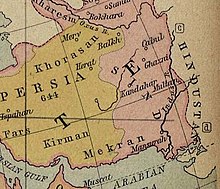History of Arabs in Afghanistan
The history of Arabs in Afghanistan spans over one
First wave


At the end of the 7th century, the
Despite the lack of much written accounts, another famous archaeological legacy of this battle remains standing in Kabul, notably the tomb of the Shah-e Do Shamshira (translated into, The leader with the Two Swords in Persian) next to the Shah-Do Shamshira Mosque. The site, located near Kabul's market district, was built near the area where an Arab commander died.
Despite fighting heroically with a sword in each hand, one of the Muslim head commanders fell in battle. It is his memory that is honored by the mosque today. The two-story edifice was built in the 1920s on the order of King Amanullah's mother on the site of one of Kabul's first mosques.
Following the Arab confrontation, the region was made part of Khorasan with its seat of power in Herat in the west. The Arabs later partially relinquished some of their territorial control though reasserted its authority approximately 50 years later in 750 when the
It was during the reign of the
Despite maintaining some clothing customs and attire,
Second wave
| History of Afghanistan | |
|---|---|
 | |
| Timeline | |
| 410–557 | |
| Nezak Huns | 484–711 |
After the
Some Arabs from the second wave intermarried with the local population as they adopted the languages of northern Afghanistan, namely Uzbek, Turkmen, and Persian language.[9] Many settled in Kunduz, Takhar and Sar-e Pol provinces. Currently, while they still view themselves as Arab, all the Arabs from the second wave have, like those from the original wave, lost their language of Arabic, adopting Persian instead.[6]
Although some tribal names, including
The main body of the Afghan Arabs are found in
Third wave
During the 1980s
Regional groups
Balkh
Around 900 families live in Khoshal Abad and Yakhdan villages of Dawlat Abad district of the province, the villagers can trace their lineage back to the third caliphate of Uthman, in the 7th century. These families are mainly engaged in agriculture and carpet weaving. Most Arabs in
Jowzjan
There are about 1,000 families living in Hassanabad of Shebarghan, capital of Jowzjan province, and in Sultan Arigh village of Aqcha district that identify themselves as Arabs.
Nangarhar
There are many Arab families living in the city of Nangarhar, Jalalabad. The majority of the people living in the villages claim to have Arab ethnicity, Either Iraq, Egypt, and any other Arab nation. The majority have had lost their language and speak Dari with Pashto interconnected which has created an accent.
See also
- Arab diaspora
- Central Asian Arabic
- Farooqi
- Hashemi
- Muslim conquests of Afghanistan
- Pashtunization
- Arab-Persians
- Persianization
- Sayyid
- Siddiqui
- Qureshi
References
- ^ ISBN 9783110165784. Retrieved 2010-09-12.
- ^ Culture and Customs of Afghanistan By Hafizullah Emadi, pg.27
- ^ a b Muhammad Qasim Hindu Shah (1560–1620). "History of the Mohamedan Power in India". Persian Literature in Translation. Packard Humanities Institute. Archived from the original on 2009-02-11. Retrieved 2010-09-12.
{{cite web}}: CS1 maint: numeric names: authors list (link) - ^ Afghanistan In A Nutshell By Amanda Roraback, pg. 9
- ^ Arabic As a Minority Language By Jonathan Owens, pg. 182
- ^ a b c "Arab". Library of Congress Country Studies on Afghanistan. Library of Congress. 1997. Retrieved 2010-09-12.
- ^ An Ethnohistorical Dictionary of the Russian and Soviet Empires By James Stuart Olson, pg. 38
- ^ Arabic As a Minority Language By Jonathan Owens, pg. 183
- ^ Arabic As a Minority Language By Jonathan Owens, pg. 184
- ^ Islamic peoples of the Soviet Union, by Shirin Akiner, pg. 367
- ^ a b Luke Griffin (January 14, 2002). "Ethnicity and Tribe". Illinois Institute of Technology. Paul V. Galvin Library. Archived from the original on December 8, 2006. Retrieved 2010-09-12.
- ISBN 9780292710665.
- ^ Dawood Azami (January 17, 2008). "Kandahar's cemetery of 'miracles'". BBC Pashto service. BBC News. Retrieved 2010-09-12.
- ^ a b Zabiullah Ehsas (March 9, 2011). "Arabs in Balkh fear language, culture is dying". Pajhwok Afghan News. Retrieved 2015-09-01.
- ^ Bakhtar News
